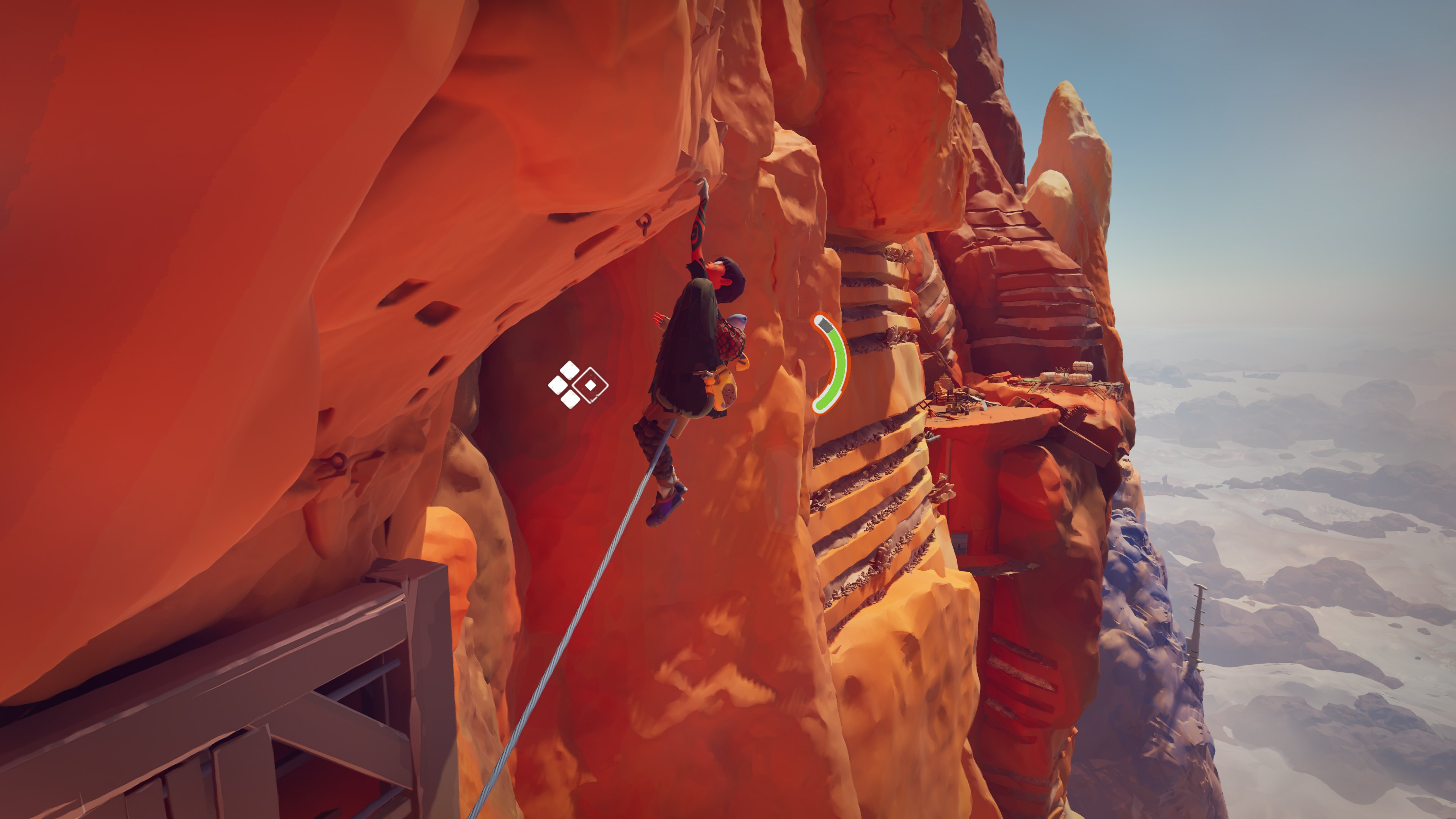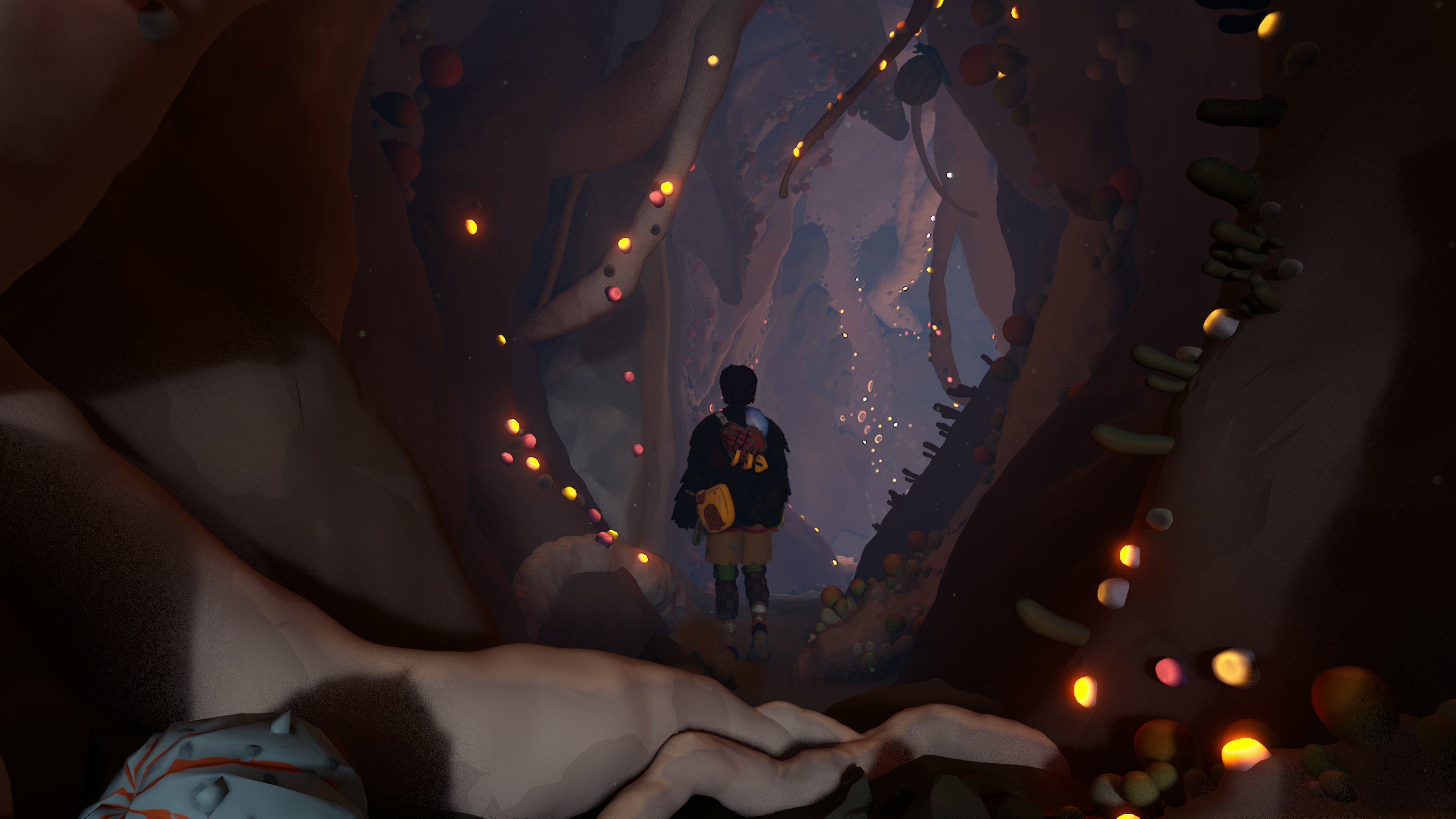
One hand over the other, I cling to rock after rock on the face of an imposing cliff. With the sun beating down, every move is exhausting, forcing me to stop and rest at each grip. I curse the times I doubled back or missed a jump on the way up for leaving me with so little energy. But the edge of the cliff is nearly in reach now. I jump with the last of my strength and hope I can scramble over with what I’ve got left.
When you emerge from the desert at the start of Jusant, you have one goal: make it to the top of the impossibly tall mountain known as the Tower. A vertical shaft of rock reaching from what used to be the sea floor into the clouds, the Tower is divided into distinct strata, where generations of people have made their homes. Despite its bare-bones story, Jusant manages to paint a compelling picture of this Tower-bound society, but its main attraction is the intricate, occasionally fiddly process of climbing, one handhold at a time.
Hold on Tight

For how often video games are nominally about grand journeys — to explore the stars or slay a dragon, for instance — they rarely focus on the process of movement itself. Despite being very different games, Jusant feels like a close cousin of Deäth Stranding. Both games zoom in on the mechanics of their journeys, forcing you to take things one step at a time.
In Jusant, that means using both triggers on a controller to grasp with your left and right hands, individually, while aiming for the next handhold with the left joystick. What at first feels like a suffocatingly precise level of control soon turns into an easy rhythm. Aim at the next rock, press the trigger, aim, press, aim, press, all with your eyes constantly scouting ahead for the next move. The movement of joystick and triggers starts to feel almost automatic, interrupted only when you need to leap for a distant handhold or stop to rest and recharge your stamina.
Jusant’s precise controls turn it into a nearly mesmerizing experience, but a few quirks break its hypnotic hold. Your climber tends to reach for the nearest rock in the direction you press, rather than following your movements exactly. Combined with occasions when rocks that look grabbable aren’t or vice versa, this leads to some frustrating moments where the path ahead looks clear but you just can’t use it, though this was rare.
Similarly, there are times when you need to dangle from the end of your rope — either to swing through open air or scramble along a cliff face — where your character tends to fling in unexpected directions. None of these issues came close to souring the experience, but they did interrupt what was otherwise a joyful climb.
Jusant takes its time adding meaningful twists to its climbing mechanics. For the first hour or so I was worried it wouldn’t be enough to support its own weight, but as you move through the Tower’s distinct biomes, from sun-scorched rocks to caves illuminated by glowing plants, new mechanics are stacked one on top of another. While you manage your own stamina, you can also use the ability of a small frog-like critter you carry with you, called a ballast. The ballast releases a short-range burst of energy that living things in the environment react to. It can make vines with convenient handholds slither across the cliff, cause climbable flower buds to sprout, and attract flying creatures that add some extra oomph to your jump.
After you leave the lowest tier of the Tower, the environment also gets much more complex. Where at first there’s only one way up the mountain, Jusant becomes a more open-ended affair, offering multiple paths to your next goal and well-hidden detours that lead to collectibles like rock cairns and mosaics. These collectibles don’t provide any tangible benefits, serving more as symbols of the Tower’s culture to bring the world to life. Learning to manage your stamina, seek out efficient routes, and place pitons to anchor swings all become crucial skills, and finding harmony between your own ability and the environment around you feels fantastic.
Water(less) World

While it’s not entirely clear from the outset, your climb is more than just a particularly hardcore workout. In the world of Jusant, the oceans have disappeared and rain is a memory distant enough to become myth.
A short way into the climb, you come across a massive monument — a tower built into the Tower — with a series of giant pipes like twisting antlers jutting out of the top. As you approach, your nameless climber takes a conch shell from their pack, fits it into the apparatus, and blows. Suddenly, plants grow on the rocky surface of the tower and it’s revealed that you’re here to bring life back to this wasteland.
Jusant tells its story without any dialogue, as you never encounter another person on your climb. In fact, what story it has isn’t about you at all. As you climb, you come across journal entries and other notes left by the Tower’s previous inhabitants. They detail the rhythms of daily life, from grocery orders to neighborly feuds. At first, they seem totally irrelevant, but as you go higher, they cohere into something more interesting. Through these notes, you learn the story of the Tower — how climate change has forced its citizens to move up and down in altitude seeking water, arable land, or shelter from blazing heat and constant storms.
Another story also comes into focus, charting the journey of an explorer named Bianca who sets out with a crew to find out once and for all what happened to this world’s water. By taking the focus off your character and putting it instead on Bianca, Jusant situates your journey in a larger context. While you may be the only one with the key to solving the Tower’s problems, you’re just one in a long line of people who lived their whole lives here, some seeking to do what you’re now doing and some just trying to make life as good as possible for themselves and their loved ones.
Peak Performance

It took me a while to find my rhythm with Jusant. At first, I struggled against its limitations, craving more challenge. I wanted a camera to capture its gorgeous views and an almanac to catalog all the cute little critters that scurried beneath my feet or flew away as I approached. I wished for a stronger story in the notes I found, or to see just a few more people to give the world life.
What I was asking for was a way to control the world, but Jusant just wanted me to enjoy moving through it. Jusant did give me most of what I wanted in the end, but the real turning point was just learning to accept what the game is. It’s about moving through a society that’s had to change or disappear, enjoying the bits of the past left for you and lamenting what was lost. When I learned to appreciate the poignancy of cracked tiles on the bottom of a fountain with no water running from its carved mouth, I started to love Jusant.
8/10
Jusant is available on PlayStation 5, Xbox Series X/S, and PC, and it’s included with Xbox Game Pass. Inverse reviewed the game on PC.
INVERSE VIDEO GAME REVIEW ETHOS: Every Inverse video game review answers two questions: Is this game worth your time? Are you getting what you pay for? We have no tolerance for endless fetch quests, clunky mechanics, or bugs that dilute the experience. We care deeply about a game’s design, world-building, character arcs, and storytelling come together. Inverse will never punch down, but we aren’t afraid to punch up. We love magic and science-fiction in equal measure, and as much as we love experiencing rich stories and worlds through games, we won’t ignore the real-world context in which those games are made.







